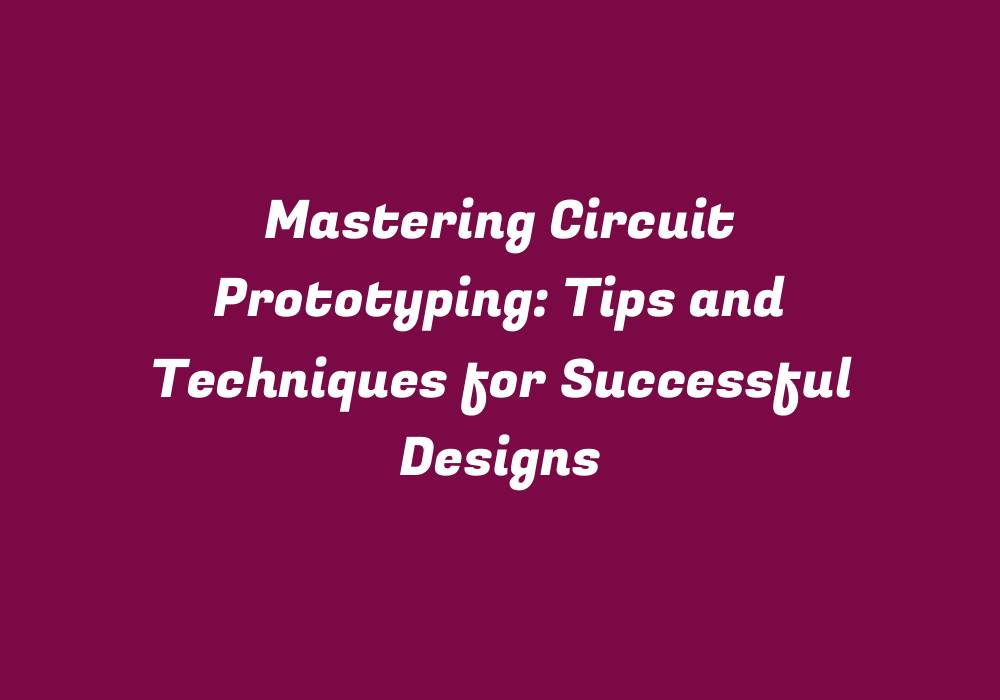Mastering Circuit Prototyping: Tips and Techniques for Successful Designs
Prototyping is an essential process in creating any circuit. It allows you to test your ideas, refine the design, and ensure that it works as intended before manufacturing or implementing it on a larger scale. Whether you are new to circuit prototyping or a seasoned professional, there are always tips and techniques you can learn to improve your designs and make them more successful. In this article, we’ll explore some key aspects of mastering the art of circuit prototyping.
Understanding Your Goals
Before diving into the world of circuit prototyping, it is crucial to have a clear understanding of your goals and objectives. Knowing what you want to achieve from the outset will guide your design choices and help optimize the overall efficiency of the prototype. Consider factors such as cost, power consumption, reliability, and space requirements to ensure that your circuit prototyping efforts align with these objectives.
Choosing the Right Tools and Materials
Having the right tools and materials for prototyping is vital for ensuring a successful outcome. These essentials typically include a breadboard, a multimeter, soldering equipment, component leads, wires, resistors, capacitors, and an assortment of other components required for your circuit design. Depending on your project’s complexity, you may also need additional tools like oscilloscopes, logic analyzers, or programmable microcontrollers.
Simplify Your Circuit Design
Keeping the circuit design as simple as possible will not only save time and effort but also make troubleshooting easier. By breaking down your project into smaller, manageable components or using modular designs, you can create a more structured approach to prototyping. This makes it simpler to identify any issues with individual parts rather than dealing with an entire, complex circuit.
Use Breadboards Efficiently
Breadboards are the go-to solution for many beginners in circuit prototyping. They offer a convenient and cost-effective way to construct temporary circuits while also allowing easy access to component leads. However, using breadboards efficiently is essential for optimizing their performance. Avoid overloading a single row of holes or placing components too close together, as this can cause issues with signal quality and reliability.
Optimize Your Circuit’s Power Supply
A well-designed power supply is crucial for the stability and functionality of any circuit. Consider using regulated power supplies to maintain consistent voltage levels throughout your design, preventing fluctuations that can disrupt performance or damage components. Additionally, make sure to account for potential power losses and use appropriate fuses to protect your circuit from overloads.
Ensure Proper Component Placement
Proper placement of components on a breadboard or circuit board is essential for preventing signal interference and ensuring the smooth flow of electricity. Follow these guidelines when arranging components:
1. Place passive components like resistors, capacitors, and inductors close to their power supply to minimize voltage drop.
2. Connect active components such as transistors and ICs with their power supplies in close proximity for optimal performance.
3. Keep the length of component leads short to minimize signal loss and improve reliability.
Use Prototyping Software
Prototyping software can be a valuable asset during the circuit design process, enabling you to simulate your circuits virtually before constructing them physically. This helps identify potential issues early on and allows for quick adjustments, saving time and effort throughout the development cycle.
Testing Your Circuit Prototype
Once your circuit design is complete, it’s essential to thoroughly test its performance before moving forward. Some common issues you may encounter include short circuits, incorrect voltage levels, or component damage due to excessive heat generation. Address these problems and make necessary adjustments to ensure your prototype meets the desired specifications.
Documenting Your Design Process
Documentation is an essential step in the prototyping process that helps you analyze your work, identify areas for improvement, and share insights with others. Keep a record of your circuit design, components used, test results, and any lessons learned during each iteration to inform future projects and optimize your overall development experience.
Conclusion
Mastering the art of circuit prototyping takes practice and dedication. By understanding your goals, selecting the right tools and materials, simplifying your design, utilizing breadboards efficiently, optimizing power supply, ensuring proper component placement, employing software aids when possible, testing thoroughly, and documenting your process, you can significantly improve the success of your circuit prototyping projects.
Remember to always be open to learning new tips, techniques, and strategies that can further enhance your circuit design skills. With a combination of persistence and dedication, your efforts will pay off in the form of successful, well-functioning circuits that meet or even surpass your original goals.
